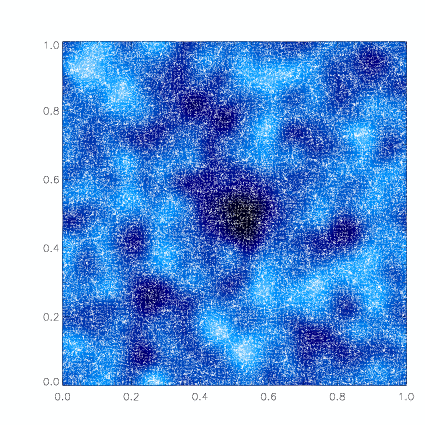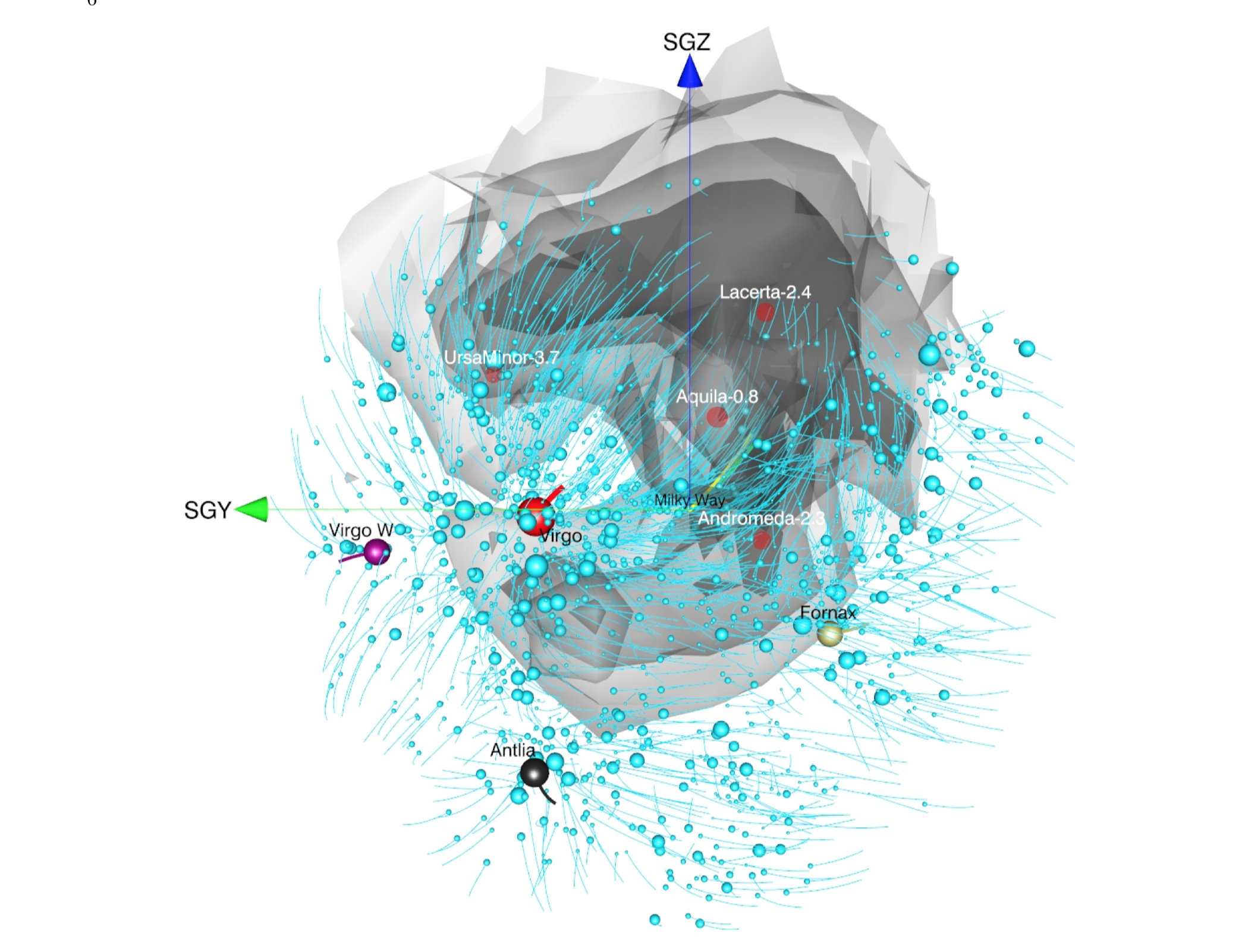The presence of the Bootes void, whose diameter of nothingness spans 330 million light years, is very problematic to the current Big Bang theory as told by the Lambda-CDM model. According to the assumptions that the early universe was mostly homogenous and isotropic this supervoid should not exist.
It should contain between 2,000 to 10,000 galaxies as opposed to the 60 galaxies that have so far been identified. Add to this that these 60 galaxies are not homogeneously distributed throughout the volume of the void as would be expected. Rather they are confined to a tube shaped region running through the middle of the void.
Applying the definition of sufficiently large, of the cosmological principle, of about 250 or 330 million light years. Looking at this volume of the universe that is sufficiently large enough but does not look the same as all the rest. In fact it is a big empty supervoid of nothingness. So how, according to the standard model of cosmology, can the presence of this supervoid be explained?
The surprise discovery in 1998 that the expansion of the universe was not slowing down; but rather accelerating, was a shock to cosmologists. It meant that there was some force acting or running counter to the force of gravity. In order to explain this mysterious force the phrase dark energy was coined. Like dark matter, dark energy was an invisible component that we could not see directly but whose influence we could measure. Unlike dark matter which has the effect of gravitational attraction, dark energy has the counter effect of gravitational repulsion. [1]
Galaxies that were initially homogeneously spread throughout the early cosmos have over time, under the influence of gravity upon each other, grouped together. These groups grew to become clusters and then superclusters of galaxies. [2]

A void simulation, in a LCDM Universe. The simulation is based upon a CRF realization centered on an initial trough in the density field. [3] [4]
The same idea applied to voids merging together to finally become supervoids was thus postulated. Voids, whose volume is filled with dark energy, are attracted to each other. Acting and behaving like soup bubbles merging together voids, drawn towards each other, merged together forming larger and larger voids. [3] [4]
Thus the Bootes void was formed overtime in a manner similar to the merging of soup bubbles into a singular bubble. The 60 odd galaxies that were caught between the merging bubbles of the void were herded like cattle into being confined inside a tube shaped region running through the middle of the void.
This I think is a very fair and reasonable explanation as to why the Bootes void exists. It sounds to my ears a good explanation and if I weren’t trying to give an alternative and simpler explanation as to why the Bootes void exists then I would accept this.
There are a lot of cosmologists, on the other hand, who don’t accept this explanation because in looking at the details the length of time it would have taken for such a large supervoid to have formed was far longer than the age of the universe. Simply put, the universe is not old enough for such a large supervoid to have already formed.

As a way to test my idea that the Bootes void was formed because our universe flowed around a hypothetical massive starlike object I considered the motion of galaxies close to the void. So if my hypothesis is valid then I would expect the galaxies close to the Bootes void to be flowing towards and then around the void. This would be similar to the flow of water in a river flowing around a given stone. Conversely, if voids formed like merging soap bubbles I would expect the motion of galaxies to be fairly randomly distributed. Although I have not tested this idea on the Bootes void, as of yet, a recent publication mapping the Local Void shows the motion of galaxies to be flowing around the void away from the direction of the Virgo supercluster. [5]
The figure shows the orbits derived from the numerical action methods of Shaya et al. superimposed on the Local Void iso-density contours. Orbits systematically descend out of the void (06.11). In this figure only, the green-blue (SGY-SGZ) coordinate arrows have length 3500 \( km s^{−1} \).
But the real elephant in the room is not the Bootes void when taking the age of the universe into account. The real elephant in the room is the Eridanus supervoid measuring around 1000 million light years in diameter. Also known as the cold dark spot on the microwave background sky the Eridanus supervoid existed 300,000 years after the Big Bang event. If supervoids take time to evolve and cosmologists argue that the universe is too young for the Bootes void to have formed, then how did the Eridanus supervoid come into existence?
Particle animation of model that focuses on the initial jet formation and the subsequent void that develops as the jet moves away. In this model we add an additional point force field to act as the explosive force of the supernovae event. This is particularly to demonstrate how a supervoid can develop at the end of the jet’s formation. You can download the Blender model file by clicking this link.
Some cosmologists, who with all due respect have based their lives work on the homogenous and isotropic cosmological principle, are so desperate in order to explain the Bootes void that they turn to a higher power in order to explain its existence. No not God! Aliens!
Yes the explanation for its existence is because of aliens. You always know when a scientific theory is in trouble when in order to explain it you have to call upon a higher power. In this case, it’s aliens!
The Kardashev scale is a method of measuring a civilisation’s level of technological advancement based on the amount of energy a civilisation is able to use. Proposed by Soviet astronomer Nikolai Kardashev in 1964 he proposed three designated categories.
A civilisation whose energy production capability is equal to \( 10^{16} \) watts is the first of the three designated categories. Namely a Type-I, or planetary civilisation, can use and store all the energy which reaches the host planet from its native sun.
Moving up the scale, a Type-II civilisation, called a stellar civilisation, could harness the total energy output of a star equal to around \( 10^{26} \) watts. One hypothetical concept for farming all the energy from a star is the Dyson sphere. A Dyson sphere is a device which would encompass the entire star in order to harvest its total energy. A star surrounded by a Dyson’s sphere would thus not emit any light into interstellar space and hence we would not be able to see that star from here on Earth.
A Type-III civilisation, or a galactic civilisation, can control energy on the scale of its entire host galaxy. So instead of just harvesting all the energy from one star a Type-III civilisation can farm the energy of all the stars in a galaxy consuming \( 10^{36} \) watts. That’s a Dyson sphere around one hundred billion stars in a given galaxy.

Energy consumption estimated in three types of civilizations defined by Kardashev scale
We humans don’t even rate as being a Type-I civilisation yet.
Popularised by scientists like Carl Sagan this classification has since been extended to define Type-VI and Type-V civilisations. A Type-VI civilisation has an energy production capability of \( 10^{46} \) watts. This is something of a kin to a civilisation that could tap into the very power of the universe. They are Q’s of Star Trek or the Archangels of God.
Type-V would be to us a God. Capable of manipulating the universe and beyond. A Time Lord without measure.
So why is all this relevant? Well for one I wish to show you the desperation of some cosmologists in trying to explain the presence of the Bootes void by a hypothetical Type-VI civilisation. The explanation being that the volume of the Bootes void is full of galaxies its just that all their stars are covered in Dyson spheres. Some sort of super AI replicating intelligence is exponentially building spheres around the suns of all the galaxies in the Bootes void.
I like this idea as it is completely mad but not very authentically original. I mean building the same sphere over and over again billions of times; its just lacks any creative thought and this from a super intelligent advanced civilisation. It doesn’t scan.
If I were a member of such an advanced alien civilisation I wouldn’t be consumed by yet looking to increase the energy production capacity by building yet another boring old Dyson sphere. I would probably look to nurture the younger civilisations. But by the laws of the verse this is strictly not really the job of any Type-VI civilisation.
And by extension neither can a Type-III, Type-II or Type-I civilisation be allowed to help nor or interfere in the natural evolution of another planet’s ecology where another such civilisation may come to rise. This is the universal prime directive that no civilisation in the verse will cross lest they incur the wraith of the real powers who existed long before the universe came into being.
This job belongs to those coming from a Type-V civilisation.
References:
- [1] What is dark energy? - Andy Briggs
- [2] Galaxy Formation, Data Visualization - Max-Planck Institute
- [3] Cosmic Voids, much ado about nothing - Rien van de Weygaert, Kapteyn Astronomical Institute
- [4] Cosmic Voids: Structure, Dynamics and Galaxies - Rien Van de Weygaert, Erwin Platen
- [5] Cosmography of the Local Void. R. Brent Tully, Daniel Pomarede, Romain Graziani